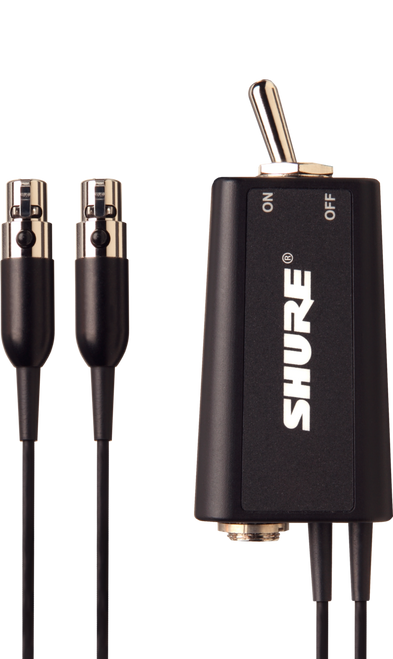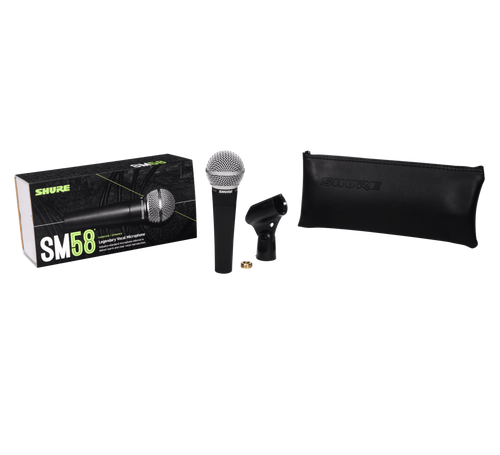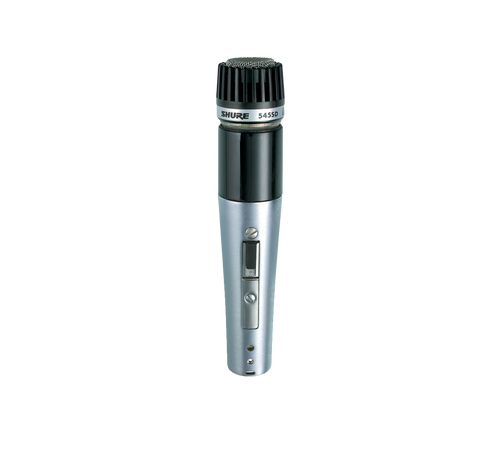Product Description
Shure A120S In-Line On/Off Switch
The Shure A120S In-Line On/Off Switch is an in-line, balanced, locking or momentary switch for a microphone. The A120S can be configured in several ways to meet different user requirements. Typical use cases include adding Latch On/Off, Push-To-Talk, or Push-To-Mute (cough button) to a microphone. The A120S is contoured to fit comfortably in the hand, and an attached belt clip rotates to four positions to allow convenient mounting. The A120S can be wired Normally-Open or Normally-Closed, and can be used with a balanced mono audio signal or an unbalanced stereo audio signal. (Note: A120S is supplied unterminated; the installer must solder appropriate wiring to provide the function desired.) Its pushbutton combines with a rotary knob to provide either spring-return momentary or locking action. The unit is supplied with a crimp-on strain relief for 6.4mm (0.25-in.) diameter cable and with a flex relief for either large or small diameter cables.
General Description
The A120S Accessory in-Line Switch can be used to add an On/OFF, Push-To-Talk, Cough Button, or Transmitter-Relay Keying function to a microphone or other device rated at up to 3 amps ac (0.5 Adc) 125V, non-inductive load. The switch has gold-plated contacts for reliable performance even in low-current circuits. The switch is a double-pole doublethrow type for maximum versatility. Its push button combines with a rotary knob to provide either spring-return momentary or locking action.
The unit is supplied with a crimp-on strain relief tor 6.4mm (0.25-in.) diameter cable and with a flex relief for either large or small diameter cables. The permanently attached belt clip can be rotated on the case to any of four positions for the most convenience in use.
Operation
| Switch Function | Rotary Knob Position |
|---|---|
| On/Off (Button remains down until depressed a second time) | Locking |
| Push-To-Talk (Button remains down only while depressed) | Momentary |
Locking the Switch Button Down
The switch button can be locked down by following these steps:
- Turn the rotary knob to Locking.
- Press the switch button down.
- Turn the knob to Momentary.
The button will remain locked down until the knob is returned to locking and the button is depressed again.
Switch Installation and Wiring
- For thicker cable (e.g., one 6.4 mm [0.25 in.] diameter cable or two 3.8 mm [0.15 in.] diameter cables), cut off the bottom of the flex relief at the rib. For narrower cable (e.g., one 2.3 mm [0.39 in.] diameter cable), use the entire flex relief as supplied. Thread the cable(s) through the flex relief.
- For one 6.4 mm diameter cable (0.25 in.), crimp the strain relief to the cable making sure the eyelet is toward the raw end of the cable. Leave enough raw cable above the strain relief to permit soldering the individual conductors to the switch terminals.
For all other cables, loosely knot the cable above the flex relief to form a strain relief. Leave enough raw cable above the knot to permit soldering the individual conductors to the switch terminals.
- Solder the conductors to the switch terminals to obtain the desired function (see Figure 3 for switch configuration.) Take care not to leave long bare conductors that may bridge across terminals and make unintended connections.
When the switch is used to make connections in the middle of a cable run, it is very important to preserve continuity in the cable shield. If a splice is necessary for this, be sure it is insulated from other terminals, or you may employ an unused switch terminal to make the connection. Leaving the shield discontinuous may cause undesirable hum in a circuit.
- Assemble the switch by inserting the tab on the bottom back of the switch into the slot in the upper case front. (See Figure 4)
- Insert the flange in the flex relief into the slot between the case bottom and the small horizontal projection.
- If the strain relief is used, align its hole with the hole in the center boss in the lower case front. Align the cable to one side of the boss.
If the cable is knotted to provide a strain relief, the center boss in the case may be inserted through the center of the knot with the cable lying to the side of the boss.
- Use the three provided thread-forming screws to fasten the case back to the case front, making sure not to pinch any leads. (If the strain relief is used, make certain that it is captured by the screw through the lower center back of the case.)

FIGURE 1: FLEX RELIEF

FIGURE 2:

FIGURE 3: TERMINAL SIDE OF SWITCH

FIGURE 4: ASSEMBLING THE SWITCH








